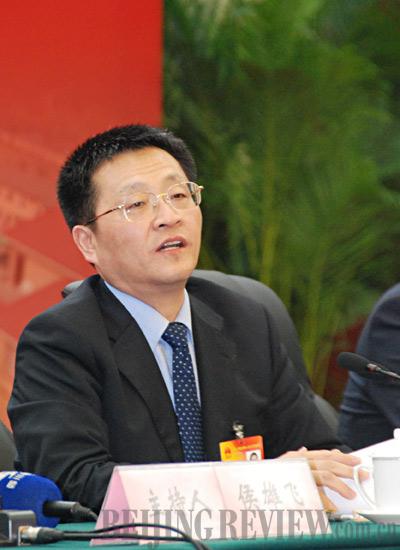|
 |
|
Ge Honglin, mayor of Chengdu, capital city of southwest China's Sichuan Province, speaks at a press conference in Beijing on March 4 (CHEN RAN) |
New thinking on building a new socialist countryside has been introduced and implemented in post-quake reconstruction, a top official said.
Ge Honglin, mayor of Chengdu, capital city of southwest China's Sichuan Province, made the remarks at a press conference in Beijing on March 4.
According to Ge, the "new thinking" refers to abiding by four principles—development that integrates local industries and economic elements, the diversity of spatial layout and architectural forms, the compatibility of the surrounding environment with production and the local lifestyle, and the sharing of infrastructure and public facilities.
The devastating 8.0-magnitude earthquake that occurred on May 12, 2008 in Wenchuan, less than 100 km away from Chengdu, left 4,307 Chengdu residents dead, and 2.82 million affected. The city's direct economic loss hit 98.4 billion yuan ($14.4 billion).
"Abiding by the four principles could help prevent post-quake reconstruction from becoming either a pure repair of buildings and roads or a simple copy of urban residential complex construction," Ge said.
Ge said the general planning program of Chengdu's post-quake restoration and reconstruction, including 36 sub-programs under nine planning categories, had finished compilation, thanks to some 4,000 participants from more than 200 high-level planning and design institutions at home and abroad.
The city also organized design competitions for rural housing reconstruction. The winning designs have been included in free guides to help local farmers build their own houses as part of post-quake reconstruction.
"As far as I know, the technical guidelines and management practices of the new rural planning and construction that we introduced are the first of their kind in China," Ge said.
Currently, 2,276 out of 3,147 post-quake reconstruction projects in Chengdu have been finished. Infrastructure restorations, including urban and rural housing, roads, irrigation, electricity and telecommunication, have basically been completed; rural housing reconstruction is 99.4 percent done.
Ge said Chengdu will accelerate its construction of 230 residential areas for quake-affected farmers and another 450 relocation spots, with basic service facilities such as cultural and sports centers, markets and social welfare centers. Moreover, each village/commune will be allocated special funds worth 200,000 yuan ($29,000) each year for public service and social management to better meet farmers' needs. | 